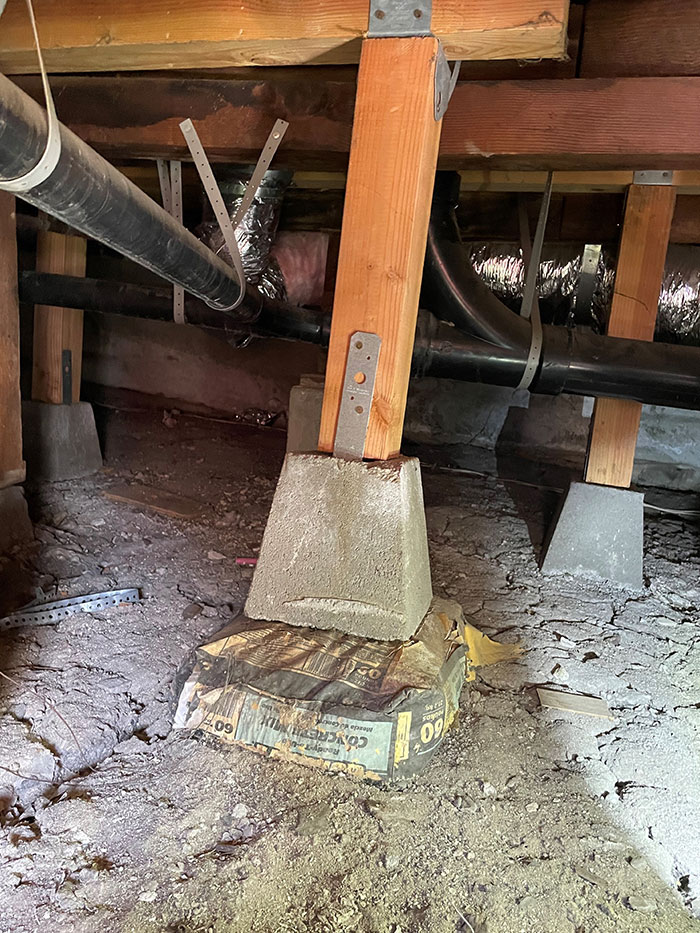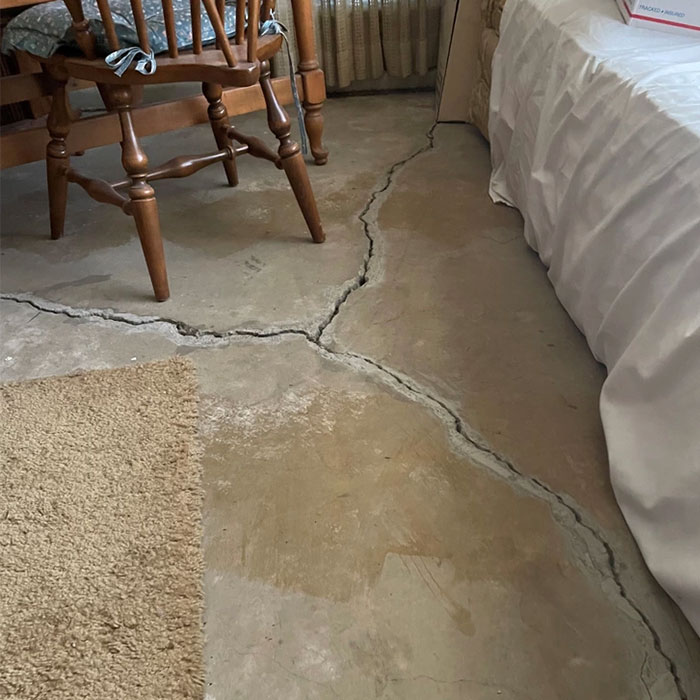
25 Times Building Inspectors Spotted The Most Horrifying Things During Structural Assessments (New Pics)
How many of you have been actually worried about the structural integrity of your homes, offices, shops, or hospitals? Unless there is a noticeable crack in the wall or sheets of drywall falling from the ceiling, we don’t really overthink it that much. In reality, the house’s foundation could be failing, and you would have no idea because sometimes it can be hard to spot. Therefore, it’s always better to be safe than sorry. Maintaining the foundation of your house can save you time, money, and, most importantly, your safety. It can cost thousands of dollars to fix when it’s too late, and severe crumbling is done.
However, there are professionals whose jobs are to provide structural checks of the buildings. And things they uncover during these assessments might seriously surprise you and make you wonder how some of these buildings are still standing. The building inspectors from Alpha Structural, Inc. share the most shocking and hazardous constructions they found while on the job. Scroll down to see some of their photos, and try not to judge the people who came up with some of these “art installations.”
Have room for some more construction horror? Check out previous posts from older structural inspections here and here.
More info: AlphaStructural.com, Facebook, Instagram, Twitter, Imgur
#1

Image source: AlphaStructural
The soil eroded and left a massive gap in the hill as it all came sliding down. All the extra weight causes the wall to get to a point that it is not strong enough to support the soil, it becomes overloaded, and fails.
A drainage system behind a wall like this could’ve potentially helped.
A drainage system can include a layer of gravel, drainpipes and weep holes that redirect the water that would usually sit behind the wall.
Retaining walls typically are not designed to resist the weight of soil and water. So, when hydrostatic pressure builds up behind a wall, it can become overloaded and fail.
The wall caused damage inside the home too.
This could’ve been much worse.
#2

Image source: AlphaStructural
This home’s retaining wall failed during the heavy rainfall Los Angeles experienced a couple of weeks ago. A common reason why retaining walls fail is saturated soils, usually from rain, with a lack of a proper drainage system behind the wall.
#3

Image source: AlphaStructural
The pig from the three little pigs story did a better job at building a house of bricks.
This looks rushed. Maybe the big bad wolf was closer than they thought.
#4

Image source: AlphaStructural
This apartment complex’s tucked-under garage has begun to spall.
Spalling can cause serious injuries as it can damage the whole structure to a point of failure.
There are three stories above this garage.
#5

Image source: AlphaStructural
Rebar, which is steel reinforcement, makes a wall stronger and reduces cracking and leaning. Older block walls may not have rebar in them and are more apt to crack or fail.
The majority of maintenance and repairs on a block or concrete wall can be done by masonry or concrete wall contractors. In extreme circumstances, a geotechnical and/or structural engineer may be needed.
I know it’s hard but take your eyes off the wall and look up to the balcony…
Yeah, that’s not supposed to happen either.
#6

Image source: AlphaStructural
Trees and plants need to be carefully chosen when this close to a wall. Usually, you would want to keep trees at least 15ft. away. Most of a tree’s growth happens out of sight, and those roots can do real damage.
#7

Image source: AlphaStructural
We did this assessment for a brand-new home in Los Angeles built in 2017. This is a 3.2-million-dollar home. When we went into the crawlspace, we noticed these wood pieces in odd places. We’ve seen a thing or two, so we knew we had to cut these off and inspect behind it.
When we removed the wood pieces, we immediately knew why they were trying to hide what was behind it.
Sloppy concrete work. We found several exposed spots. Leaving components of the home open to the elements can cause problems like this rusted beam. This beam is holding up three stories.
#8

Image source: AlphaStructural
Only bounce houses should move side to side. This home’s garage is clearly on its way out. Hope it’s empty.
#9

Image source: AlphaStructural
Structural support shouldn’t be a balancing game.
#10

Image source: AlphaStructural
I love magic shows.
This house impressed me with floating posts and invisible piers.
#11

Image source: AlphaStructural
This internal cripple wall is leaning to one side. I guess it’s already doing half the work for the next earthquake.
#12

Image source: AlphaStructural
The “Balcony Bill” was signed back in 2018, and for good reason. Let’s get them up to code now.
#13

Image source: AlphaStructural
This internal stem wall is leaning significantly to one side. This is compromising the structural integrity of the home as other sections now carry more weight than intended.
#14

Image source: AlphaStructural
When a deck is showing signs of wear and tear, you should look for any rusting of metal components. This isn’t only an appearance issue but, also a safety warning. The structural components of the deck could be unsafe and could cause a total collapse of the deck floor.
Steel nails that are used in deck construction are coated with a layer of zinc that protects the steel from airborne ocean water salts. Over time the zinc layer is worn down by the corrosion process. Once the zinc layer is gone, bare steel is exposed to sea salts that rapidly destroy the structural strength of the nail connections, making deck components dangerous for occupant use.
#15

Image source: AlphaStructural
Load-bearing spider webs keep this post and pier in working order.
#16

Image source: AlphaStructural
Oh look: it moves.
It shouldn’t need to be said, but no part of your home’s foundation should move with a push.
#17

Image source: AlphaStructural
Wood rot at its best… or worst.
#18

Image source: AlphaStructural
This post and pier looks funny.
Someone replaced the post with a game of jenga.
#19

Image source: AlphaStructural
They did not understand the assignment.
#20

Image source: AlphaStructural
Here we have some pretty serious spalling in a residential garage. Spalling is a term used to describe areas of concrete which have cracked and delaminated from the substrate. Concerning structural damage, it doesn’t happen overnight but persistent water leaks and failure deferred maintenance could cause significant structural issues.
#21

Image source: AlphaStructural
Stick a knife in it. It’s done and needs to be replaced.
#22

Image source: AlphaStructural
Signs of slab damage are important to assess and handle as soon as possible.
#23

Image source: AlphaStructural
This bolt has rusted and allowed the foundation wall to begin to spall. Horizontal foundation cracks are the most concerning. As you can see, the crack has been patched before, but this is something that needs to be replaced ASAP.
#24

Image source: AlphaStructural
The picture does not do the wall justice. This retaining wall is massive, and it is also failing.
Yes, it has been braced. No, it doesn’t make it less scary.
#25

Image source: AlphaStructural
One of our Senior Structural Assessors, Kyle, can be seen here inspecting a failing retaining wall.













Got wisdom to pour?
I advise you to think through and prepare a high-quality drainage system before building a house, which will increase the service life of the building’s foundation several times. I do not recommend forgetting about the blind areas and concrete platform on the adjacent territory. You can learn more about this here https://bestplumbers.com.au/plumbing-guides/french-drain-system/. If you need to protect your site from excess moisture, then I advise you to install several types of drainage